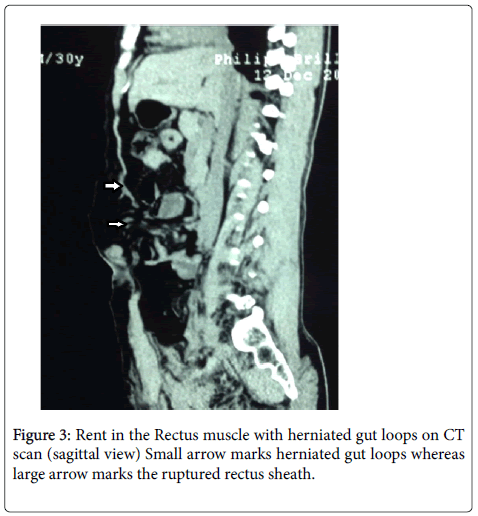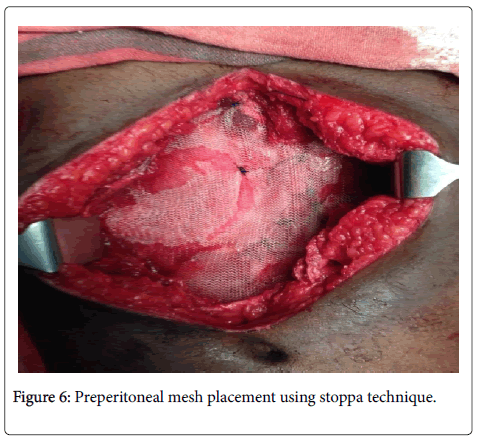Case Report Open Access
Traumatic Abdominal Wall Hernia-A Rare Case Managed with Preperitoneal Mesh Placement Using Stoppa Technique
Satpal Hans, Manjit Singh Khalsa, NIrmal Singh, Anoop Handa and Amiy Arnav*General Surgery, Government medical College Amritsar, India
- Corresponding Author:
- Amiy Arnav
Government medical College Amritsar
General Surgery, Room no. 29, F block
Boys Hostel, Government Medical College
Amritsar,Punjab 143001, India
Tel: +918289025045
E-mail: arnavamiy@gmail.com
Received Date: June 03, 2015; Accepted Date: January 22, 2016; Published Date: January 25, 2016
Citation: Hans S, Khalsa MS, Singh N, Handa A, Arnav A (2016) Traumatic Abdominal Wall Hernia-A Rare Case Managed with Preperitoneal Mesh Placement Using Stoppa Technique . J Clin Diagn Res 4:123. doi: 10.4172/2376-0311.1000123
Copyright: © 2016 Hans S, et al. This is an open-access article distributed under the terms of the Creative Commons Attribution License, which permits unrestricted use, distribution, and reproduction in any medium, provided the original author and source are credited.
Visit for more related articles at JBR Journal of Clinical Diagnosis and Research
Abstract
Introduction: Traumatic hernia of the abdominal wall is a rare entity and over the past century~50 have been reported in the literature. In adults, the presentation can vary substantially and the diagnosis is difficult. We present a rare case of traumatic hernia in an adult repaired successfully with meshplasty using stoppa technique.
Case presentation: A 30-year-old man presented with blunt trauma to the abdomen following a Motor vehicle accident. He was hemodynamically stable, with a central abdominal parietal wall swelling and bruising. A computed tomography scan revealed herniation of bowel loops in the area with minor intra-abdominal injuries. Urgent laparotomy with preperitoneal meshplasty using stoppa technique and layered fascial closure done and patient recovered well.
Conclusion: Following blunt abdominal trauma, particularly high-velocity injuries, a high index of suspicion must be reserved for parietal wall swellings, as missed hernias in this setting have a high risk of strangulation. Computed tomography is the best aid to diagnosis. Management of each case needs to be individualized and meshplasty using stoppa technique can be used as an effective method.
Introduction
Traumatic abdominal wall hernia (TAWH) has been defined as ‘herniation through disrupted musculature and fascia associated with adequate trauma, without skin penetration, and no evidence of a prior hernia defect at the site of injury’ [1]. They are rare and over the past century about 50 have been reported in the literature [2]. Debate surrounds management strategies. Some reports advocate a conservative approach with operative intervention at a later stage if indicated, whereas others have promoted immediate surgical intervention. We present a case of a 27-year-old male with significant disruption to his anterior abdominal wall with associated thoracoabdominal injuries who was managed operatively.
Case Report
A 30 year old male presented to surgical emergency with alleged history of road side accident and was crushed between two buses while cleaning the windshield of front of one bus and other bus ran into it. Patient sustained trauma to the trunk. He complained of pain, swelling over the umbilical region and pain over right hip (Figure 1). On examination, patient was conscious and haemodynamically stable. Per abdomen examination showed visible swelling in umbilical and epigastric region with overlying bruising of skin. Palpation revealed tender, firm, smooth margins, irreducible, immobile and non-pulsatile swelling which increased in size on increasing abdominal pressure. Musculoskeletal examination revealed tenderness over right hip and lower spine. Urgent whole abdomen CT scan revealed rent in rectus muscle of about 3 cm with evidence of herniation of small gut loops with mesenteric fat at the supraumbilical level and fracture of superior and inferior pubic rami on right side, fracture of transverse process of third, fourth and fifth vertebrae (Figure 2).
There was significant soft tissue edema and stranding of the subcutaneous fat in relation to inferior anterior abdominal wall on anterior and right lateral aspect (Figure 3). Rests of abdominal solid organs were found to be normal. Emergency exploratory laparotomy was carried out through midline incision. A subcutaneous flap was raised up to 3 to 5 cm around the defect and an irregular defect in anterior rectus sheath and rectus muscle was found with mesenteric tears. Minor peritoneal collection with no associated intra-abdominal organ injury was found (Figures 4 and 5).
Thorough abdominal lavage was done and a drain was placed in pelvis. Irregular margins of peritoneum and rectus sheath freshened. The posterior rectus sheath and peritoneum were closed primarily with 2:0 absorbable suture, then polypropylene mesh of suitable size with a minimum of 3 cm overlap beyond the margin of the defect were placed over posterior rectus sheath/peritoneum and rectus muscle and fixed in four corners with 2:0 polypropylene sutures taken out through abdominal muscle on the anterior rectus sheath and skin (Figure 6). The anterior rectus sheath was closed over the mesh with propylene sutures without tension. Post-operative patient responded well and was discharged on the 5th day. Follow up after 6 month was uneventful.
Discussion
TAWH is defined as herniation of the viscera through the abdominal wall within the context of disrupted muscle and fascia layers but with intact skin, where there is distinct history of trauma preceding the occurrence of the hernia [3]. Pre-existing hernias are excluded. Traumatic hernia of the abdominal wall is a rare injury. It is caused by trauma sufficient to disrupt fascial layers, but not the elastic skin.
Wood et al [4] attempted to classify these mechanisms into three types, namely: A) Small lower quadrant defects such as handlebar injuries; B) Larger abdominal wall defects such as motor accidents; and C) Intra-abdominal herniations such as a deceleration injury. CT scan of the abdomen with oral and intravenous contrast is the most reliable diagnostic test, although the limitation of assessment of bowel viability is accepted.
The pathophysiology of TAWH involves the application of a blunt force to the abdomen over an area large enough to prevent penetration of the skin; the tangential forces resulting in a pressure-induced disruption of the abdominal wall muscles and fascia, allowing subcutaneous herniation of abdominal viscera through the defect, as proposed by Ganchi[5]. As the skin is more elastic than the other layers of the abdominal wall, it remains intact even though the underlying musculature and fascia are disrupted which gives rise to TAWH [6,7]. In particular, the forces directed tangentially to the abdominal wall can easily produce shearing stresses to the underlying muscles, fascia, and peritoneum however,associated intra-abdominal injuries are infrequent [1].
There are case reports where a conservative approach has been adopted, although these are mainly in the paediatric group and are secondary to handlebar type injuries with minimal disruption to the abdominal cavity [8,9]. A conservative or delayed operative management strategy for low energy TAWH may be feasible, but high-energy TAWH are often associated with significant intra-abdominal injuries and an operative approach via midline laparotomy has been advocated [10]. Both mesh repair as well as primary repair have been successfully performed for treatment of traumatic hernia [11]. As there appears to be no consensus on this issue, one may conclude that lowvelocity injuries lead to less tissue necrosis, and a mesh can be used. When high-velocity injuries are present as in motor vehicle accidents, mesh may be avoided because of the high risk of infection, unless there is greater tissue loss. Treatment based on the merits of each case would again be the most prudent approach.
The hernial defect in our case was large, so decision of mesh placement was undertaken. Popularized in Europe by Rives and Stoppa, the sublay technique has proven to be very effective, with low recurrence rates (0%-23%) and minimal complications [12-15]. The procedure achieves both an anatomic and a prosthetic repair. Anatomic plasty restores the structure of the abdominal wall while placement of mesh targets the biological mesh. The technique is used in incisional hernia and bilateral inguinal hernia. In view of extensive traumatic damage to the rectus sheath, muscle and anticipated weakness of abdominal wall; widespread placement of mesh using stoppa technique was done and patient recovered well.. Exploratory laparoscopy is also being utilized in carefully selected, hemodynamically stable blunt and penetrating trauma patients to diagnose and treat intraabdominal injuries. When traumatic abdominal wall hernia is diagnosed on laparoscopy, with no obvious injuries that would necessitate laparotomy, repair may be completed laparoscopically. It is apparent that no one procedure may be optimal in all patients, thus each case must be individualized and the appropriate procedure selected [16].
Conclusion
Following blunt abdominal trauma, particularly high-velocity injuries, a high index of suspicion must be reserved for parietal wall swellings, as missed hernias in this setting have a high risk of strangulation. Computed tomography is the best aid to diagnosis. Management of each case needs to be individualized and Stoppa repair technique can also be used as mesh placement method in these cases.
References
- Damschen DD, Landercasper J, Cogbill TH, Stolee RT (1994) Acute traumatic abdominal hernia: case reports. J Trauma 36: 273-276.
- Henrotay J, Honor√?¬© C, Meurisse M (2010) Traumatic abdominal wall hernia: case report and review of the literature. Acta Chir Belg 110: 471-474.
- Donald D, Jeffery L, Randel T (1994) Acute traumatic abdominal hernia: case reports. J Trauma 36: 273-276.
- Wood RJ, Ney AL, Bubrick MP (1988) Traumatic abdominal hernia: a case report and review of the literature. Am Surg 54: 648-651.
- Dreyfuss DC, Flancbaum L, Krasna IH, Tell B, Trooskin SZ (1986) Acute trans-rectus traumatic hernia. J Trauma 26: 1134-1136.
- Selby CD (1906) Direct abdominal hernia of traumatic origin. JAMA 47:1485-1486.
- CLAIN A (1964) TRAUMATIC HERNIA. Br J Surg 51: 549-550.
- Yan J, Wood J, Bevan C, Cheng W, Wilson G (2011) Traumatic abdominal wall hernia--a case report and literature review. J Pediatr Surg 46: 1642-1645.
- Litton K, Izzidien AY, Hussien O, Vali A (2008) Conservative management of a traumatic abdominal wall hernia after a bicycle handlebar injury (case report and literature review). J Pediatr Surg 43: e31-32.
- Lane CT, Cohen AJ, Cinat ME (2003) Management of traumatic abdominal wall hernia. Am Surg 69: 73-76.
- Chen HY, Sheu MH, Tseng LM (2005) Bicycle-handlebar hernia: a rare traumatic abdominal wall hernia. J Chin Med Assoc 68: 283-285.
- Stoppa RE (1989) The treatment of complicated groin and incisional hernias. World J Surg 13: 545-554.
- Temudom T, Siadati M, Sarr MG (1996) Repair of complex giant or recurrent ventral hernias by using tension-free intraparietal prosthetic mesh (Stoppa tech-nique): lessons learned from our initial experience (fifty patients). Surgery 120: 738-743.
- Bauer JJ, Harris MT, Gorfine SR, Kreel I (2002) Rives-Stoppa procedure for repair of large incisional hernias: experience with 57 patients. Hernia 6: 120-123.
- Yaghoobi Notash A, Yaghoobi Notash A Jr, Seied Farshi J, Ahmadi Amoli H, Salimi J, et al. (2007) Outcomes of the Rives-Stoppa technique in incisional hernia repair: ten years of experience. Hernia 11: 25-29.
- Munshi IA, Ravi SP, Earle DB (2002) Laparoscopic repair of blunt traumatic anterior abdominal wall hernia. JSLS 6: 385-388.
Relevant Topics
- Back Pain Diagnosis
- Cardiovascular Diagnosis
- Clinical Diagnosis
- Clinical Echocardiography
- COPD Diagnosis
- Diabetes Diagnosis
- Diagnosis Methods
- Diagnosis of cancer
- Diagnosis of CNS
- Diagnosis of Diabetes
- Diagnostic Products
- Diagnostics Market Analysis
- Heart diagnosis
- Immuno Diagnosis
- Infertility Diagnosis
- Medical Diagnostic Tools
- Preimplementation Genetic Diagnosis
- Prenatal Diagnostics
- Ultrasonography
Recommended Journals
Article Tools
Article Usage
- Total views: 11242
- [From(publication date):
December-2016 - Apr 01, 2025] - Breakdown by view type
- HTML page views : 10402
- PDF downloads : 840






